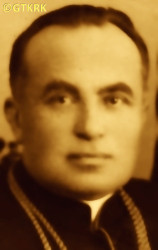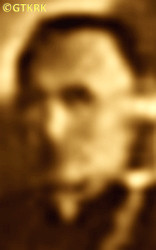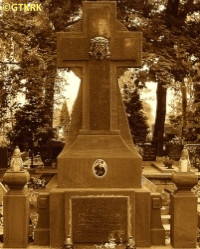Roman Catholic
St Sigismund parish
05-507 Słomczyn
85 Wiślana Str.
Konstancin deanery
Warsaw archdiocese, Poland
full list:
displayClick to display full list

searchClick to search full list by categories
wyświetlKliknij by wyświetlić pełną listę po polsku

szukajKliknij by przeszukać listę wg kategorii po polsku

Martyrology of the clergy — Poland
XX century (1914 – 1989)
personal data
surname
MĄCZKA
forename(s)
Peter (pl. Piotr)
function
diocesan priest
creed
Latin (Roman Catholic) Church RCmore on
en.wikipedia.org
[access: 2014.09.21]
diocese / province
Kielce diocesemore on
www.diecezja.kielce.pl
[access: 2012.12.28]
honorary titles
Papal chamberlainmore on
en.wikipedia.org
[access: 2014.11.22]
honorary canonmore on
honorary canon (Assumption of the Blessed Virgin Mary RC cathedral church, Kielcetoday: Kielce city pov., Holy Cross voiv., Poland
more on
en.wikipedia.org
[access: 2021.06.07])
date and place
of death
10.10.1940

Olkusztoday: Olkusz gm., Olkusz pov., Lesser Poland voiv., Poland
more on
en.wikipedia.org
[access: 2021.06.07]
alt. dates and places
of death
10.08.1940
details of death
After German and Russian invasion of Poland in 09.1939 and start of the World War II, after start of German occupation, arrested by the Germans in 09.1939 as a hostage.
Released.
Nominated — by Kielce Bp Ceslav Kaczmarek — a vicar general of the part of Olkusz county directly incorporated by Germans into Germany's Reich.
On 16.07.1940 Germans executed 20 Poles in Olkusz in retribution for a murder of German gendarme.
Fortnight later, on 31.07.1940, an armed group of Germans — Gestapo, gendarmerie and prob. Wehrmacht agents and soldiers — arrived in Olkusz.
Dragged out all men from their homes — Poles and Jews.
All were beaten and tortured in town's squares.
Fr Mączka was laying prostrated, with arms outstretched in a cross sign, on a cold floor of the parish church praying all the time for his parishioners… According to some sources was tortured as well.
As a result of the injuries sustained during this „bloody Wednesday”, as posterity called the events of that day, fell sick and perished after 10 days.
cause of death
extermination
perpetrators
Germans
sites and events
«Intelligenzaktion»Click to display the description, Collective responsibility („Hostages”)Click to display the description, Ribbentrop‐MolotovClick to display the description, Pius XI's encyclicalsClick to display the description
date and place
of birth
19.10.1884

Wawrzeńczycetoday: Igołomia‐Wawrzeńczyce gm., Kraków pov., Lesser Poland voiv., Poland
more on
en.wikipedia.org
[access: 2022.01.28]
presbyter (holy orders)
ordination
1909

positions held
from 15.05.1940
vicar general — Kielce RC diocese — in part of diocese incorporated by the Germans directly into German Reich, i.e. Olkusz county
1938 – 1940
dean — Olkusztoday: Olkusz gm., Olkusz pov., Lesser Poland voiv., Poland
more on
en.wikipedia.org
[access: 2021.06.07] RC deanery
1938 – 1940
parish priest — Olkusztoday: Olkusz gm., Olkusz pov., Lesser Poland voiv., Poland
more on
en.wikipedia.org
[access: 2021.06.07] ⋄ St Andrew the Apostle RC parish ⋄ Olkusztoday: Olkusz gm., Olkusz pov., Lesser Poland voiv., Poland
more on
en.wikipedia.org
[access: 2021.06.07] RC deanery — also: chaplain of St Blaise hospital
1925 – 1938
parish priest — Brzezinytoday: Morawica gm., Kielce pov., Holy Cross voiv., Poland
more on
en.wikipedia.org
[access: 2021.06.07] ⋄ All the Saints RC parish ⋄ Kielcetoday: Kielce city pov., Holy Cross voiv., Poland
more on
en.wikipedia.org
[access: 2021.06.07] RC deanery
1920 – 1925
parish priest — Leszczynytoday: Górno gm., Kielce pov., Holy Cross voiv., Poland
more on
en.wikipedia.org
[access: 2021.06.07] ⋄ St Jack the Confessor RC parish ⋄ Kielcetoday: Kielce city pov., Holy Cross voiv., Poland
more on
en.wikipedia.org
[access: 2021.06.07] RC deanery
1919 – 1920
parish priest — Mstyczówtoday: Sędziszów gm., Jędrzejów pov., Holy Cross voiv., Poland
more on
en.wikipedia.org
[access: 2021.06.07] ⋄ Assumption of the Blessed Virgin Mary RC parish ⋄ Sędziszówtoday: Sędziszów gm., Jędrzejów pov., Holy Cross voiv., Poland
more on
en.wikipedia.org
[access: 2020.11.27] RC deanery
1917 – 1919
parish priest — Leszczynytoday: Górno gm., Kielce pov., Holy Cross voiv., Poland
more on
en.wikipedia.org
[access: 2021.06.07] ⋄ St Jack the Confessor RC parish ⋄ Kielcetoday: Kielce city pov., Holy Cross voiv., Poland
more on
en.wikipedia.org
[access: 2021.06.07] RC deanery
1911 – 1917
vicar — Daleszycetoday: Daleszyce gm., Kielce pov., Holy Cross voiv., Poland
more on
en.wikipedia.org
[access: 2021.06.07] ⋄ St Michael the Archangel RC parish ⋄ Kielcetoday: Kielce city pov., Holy Cross voiv., Poland
more on
en.wikipedia.org
[access: 2021.06.07] RC deanery
till 1911
vicar — Chmielniktoday: Chmielnik gm., Kielce pov., Holy Cross voiv., Poland
more on
en.wikipedia.org
[access: 2022.04.12] ⋄ Immaculate Conception of the Blessed Virgin Mary RC parish ⋄ Stopnicatoday: Stopnica gm., Busko‐Zdrój pov., Holy Cross voiv., Poland
more on
en.wikipedia.org
[access: 2021.12.18] RC deanery
sites and events
descriptions
«Intelligenzaktion»: (Eng. „Action Intelligentsia”) — extermination program of Polish elites, mainly intelligentsia, executed by the Germans right from the start of the occupation in 09.1939 till around 05.1940, mainly on the lands directly incorporated into Germany but also in the so‐called Germ. Generalgouvernement (Eng. General Governorate) where it was called «AB‐aktion». During the first phase right after start of German occupation of Poland implemented as Germ. Unternehmen „Tannenberg” (Eng. „Tannenberg operation”) — plan based on proscription lists of Poles worked out by (Germ. Sonderfahndungsbuch Polen), regarded by Germans as specially dangerous to the German Reich. List contained names of c. 61,000 Poles. Altogether during this genocide Germans methodically murdered c. 50,000 teachers, priests, landowners, social and political activists and retired military. Further 50,000 were sent to concentration camps where most of them perished. (more on: en.wikipedia.orgClick to attempt to display webpage
[access: 2014.10.04])
Collective responsibility („Hostages”): A criminal practice implemented by the Germans in the occupied territories of Poland, applied from the very first day of World War II. At its core was an appointment and public announcement of a list of names of selected people whose lives depended on absolute compliance with German orders. Any violation of these ordinances, by any person, regardless of the circumstances, resulted in the murder of the designated „hostages”. In the first days of the war and occupation, it was used i.a. by the German Wehrmacht army to prevent acts of continuation of the defense by the Poles. Later, especially in the German‐run General Governorate, it was part of the official policy of the occupation authorities — collective responsibility for any acts of resistance to the occupier's practices. For the life of one German, even if death was due to customary reasons, the Germans carried out executions from a dozen to even a hundred Poles previously designated as „hostages”.
Ribbentrop‐Molotov: Genocidal Russian‐German alliance pact between Russian leader Joseph Stalin and German leader Adolf Hitler signed on 23.08.1939 in Moscow by respective foreign ministers, Mr. Vyacheslav Molotov for Russia and Joachim von Ribbentrop for Germany. The pact sanctioned and was the direct cause of joint Russian and German invasion of Poland and the outbreak of the World War II in 09.1939. In a political sense, the pact was an attempt to restore the status quo ante before 1914, with one exception, namely the „commercial” exchange of the so‐called „Kingdom of Poland”, which in 1914 was part of the Russian Empire, fore Eastern Galicia (today's western Ukraine), in 1914 belonging to the Austro‐Hungarian Empire. Galicia, including Lviv, was to be taken over by the Russians, the „Kingdom of Poland” — under the name of the General Governorate — Germany. The resultant „war was one of the greatest calamities and dramas of humanity in history, for two atheistic and anti‐Christian ideologies — national and international socialism — rejected God and His fifth Decalogue commandment: Thou shall not kill!” (Abp Stanislav Gądecki, 01.09.2019). The decisions taken — backed up by the betrayal of the formal allies of Poland, France and Germany, which on 12.09.1939, at a joint conference in Abbeville, decided not to provide aid to attacked Poland and not to take military action against Germany (a clear breach of treaty obligations with Poland) — were on 28.09.1939 slightly altered and made more precise when a treaty on „German‐Russian boundaries and friendship” was agreed by the same murderous signatories. One of its findings was establishment of spheres of influence in Central and Eastern Europe and in consequence IV partition of Poland. In one of its secret annexes agreed, that: „the Signatories will not tolerate on its respective territories any Polish propaganda that affects the territory of the other Side. On their respective territories they will suppress all such propaganda and inform each other of the measures taken to accomplish it”. The agreements resulted in a series of meeting between two genocidal organization representing both sides — German Gestapo and Russian NKVD when coordination of efforts to exterminate Polish intelligentsia and Polish leading classes (in Germany called «Intelligenzaktion», in Russia took the form of Katyń massacres) where discussed. Resulted in deaths of hundreds of thousands of Polish intelligentsia, including thousands of priests presented here, and tens of millions of ordinary people,. The results of this Russian‐German pact lasted till 1989 and are still in evidence even today. (more on: en.wikipedia.orgClick to attempt to display webpage
[access: 2015.09.30])
Pius XI's encyclicals: Facing the creation of two totalitarian systems in Europe, which seemed to compete with each other, though there were more similarities than contradictions between them, Pope Pius XI issued in 03.1937 (within 5 days) two encyclicals. In the „Mit brennender Sorge” (Eng. „With Burning Concern”) published on 14.03.1938, condemned the national socialism prevailing in Germany. The Pope wrote: „Whoever, following the old Germanic‐pre‐Christian beliefs, puts various impersonal fate in the place of a personal God, denies the wisdom of God and Providence […], whoever exalts earthly values: race or nation, or state, or state system, representatives of state power or other fundamental values of human society, […] and makes them the highest standard of all values, including religious ones, and idolizes them, this one […] is far from true faith in God and from a worldview corresponding to such faith”. On 19.03.1937, published „Divini Redemptoris” (Eng. „Divine Redeemer”), in which criticized Russian communism, dialectical materialism and the class struggle theory. The Pope wrote: „Communism deprives man of freedom, and therefore the spiritual basis of all life norms. It deprives the human person of all his dignity and any moral support with which he could resist the onslaught of blind passions […] This is the new gospel that Bolshevik and godless communism preaches as a message of salvation and redemption of humanity”… Pius XI demanded that the established human law be subjected to the natural law of God , recommended the implementation of the ideal of a Christian state and society, and called on Catholics to resist. Two years later, National Socialist Germany and Communist Russia came together and started World War II. (more on: www.vatican.vaClick to attempt to display webpage
[access: 2023.05.28], www.vatican.vaClick to attempt to display webpage
[access: 2023.05.28])
sources
personal:
www.parafia.brzeziny.org.plClick to attempt to display webpage
[access: 2020.07.31], parafiaklucze.plClick to attempt to display webpage
[access: 2020.07.31]
original images:
www.parafia.brzeziny.org.plClick to attempt to display webpage
[access: 2020.07.31], commons.wikimedia.orgClick to attempt to display webpage
[access: 2020.07.31], commons.wikimedia.orgClick to attempt to display webpage
[access: 2020.07.31]
LETTER to CUSTODIAN/ADMINISTRATOR
If you have an Email client on your communicator/computer — such as Mozilla Thunderbird, Windows Mail or Microsoft Outlook, described at WikipediaPatrz:
en.wikipedia.org, among others — try the link below, please:
LETTER to CUSTODIAN/ADMINISTRATORClick and try to call your own Email client
If however you do not run such a client or the above link is not active please send an email to the Custodian/Administrator using your account — in your customary email/correspondence engine — at the following address:

giving the following as the subject:
MARTYROLOGY: MĄCZKA Peter
To return to the biography press below:
 Click to return to biography
Click to return to biography










